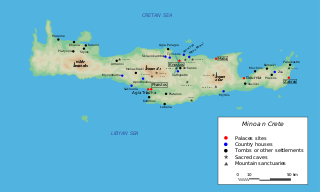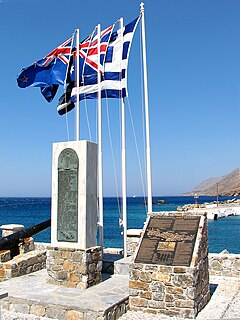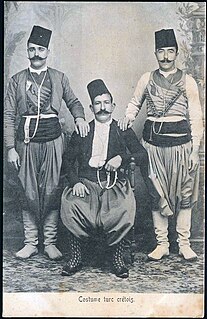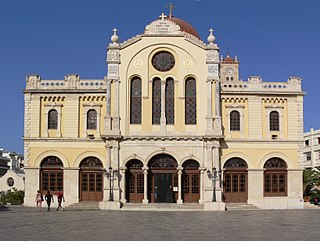Related Research Articles

The Aegean Sea is an elongated embayment of the Mediterranean Sea located between the Greek and Anatolian peninsulas. The sea has an area of some 215,000 square kilometres. In the north, the Aegean is connected to the Marmara Sea and the Black Sea by the straits of the Dardanelles and Bosphorus. The Aegean Islands are located within the sea and some bound it on its southern periphery, including Crete and Rhodes. The sea reaches a maximum depth of 3,544 meters, to the east of Crete.

Crete is the largest and most populous of the Greek islands, the 88th largest island in the world and the fifth largest island in the Mediterranean Sea, after Sicily, Sardinia, Cyprus, and Corsica. It bounds the southern border of the Aegean sea. Crete lies approximately 160 km (99 mi) south of the Greek mainland. It has an area of 8,336 km2 (3,219 sq mi) and a coastline of 1,046 km (650 mi).

Chania is the second largest city of Crete and the capital of the Chania regional unit. It lies along the north coast of the island, about 70 km (43 mi) west of Rethymno and 145 km (90 mi) west of Heraklion.

Heraklion or Iraklion is the largest city and the administrative capital of the island of Crete and capital of Heraklion regional unit. It is the fifth largest city in Greece with a population of 140,730 according to the 2011 census. The population of the municipality was 173,993.

The Minoan civilization was a Bronze Age Aegean civilization on the island of Crete and other Aegean Islands, flourishing from c. 2700 to c. 1450 BC until a late period of decline, finally ending around 1100 BC. It represents the first advanced civilization in Europe, leaving behind massive building complexes, tools, stunning artwork, writing systems, and a massive network of trade. The civilization was rediscovered at the beginning of the 20th century through the work of British archaeologist Sir Arthur Evans. The name "Minoan" derives from the mythical King Minos and was coined by Evans, who identified the site at Knossos with the labyrinth and the Minotaur. The Minoan civilization has been described as the earliest of its kind in Europe, and historian Will Durant called the Minoans "the first link in the European chain".

The Battle of Crete was fought during the Second World War on the Greek island of Crete. It began on the morning of 20 May 1941, when Nazi Germany began an airborne invasion of Crete. Greek and other Allied forces, along with Cretan civilians, defended the island. After one day of fighting, the Germans had suffered heavy casualties and the Allied troops were confident that they would defeat the invasion. The next day, through communication failures, Allied tactical hesitation and German offensive operations, Maleme Airfield in western Crete fell, enabling the Germans to land reinforcements and overwhelm the defensive positions on the north of the island. Allied forces withdrew to the south coast. More than half were evacuated by the British Royal Navy and the remainder surrendered or joined the Cretan resistance. The defence of Crete evolved into a costly naval engagement; by the end of the campaign the Royal Navy's eastern Mediterranean strength had been reduced to only two battleships and three cruisers.

The history of Crete goes back to the 7th millennium BC, preceding the ancient Minoan civilization by more than four millennia. The palace based Minoan civilization was the first civilization in Europe.

The Greco-Turkish War of 1897, also called the Thirty Days' War and known in Greece as the Black '97 or the Unfortunate War, was a war fought between the Kingdom of Greece and the Ottoman Empire. Its immediate cause was the question over the status of the Ottoman province of Crete, whose Greek majority long desired union with Greece. Despite the Ottoman victory on the field, an autonomous Cretan State under Ottoman suzerainty was established the following year, with Prince George of Greece and Denmark as its first High Commissioner.

The University of Crete is a multi-disciplinary, research-oriented institution in the island of Crete, Greece, located in the cities of Rethymnon and Heraklion, and one of the country's most academically acclaimed and reputable ones.

The military history of Greece during World War II began on 28 October 1940, when the Italian Army invaded from Albania, beginning the Greco-Italian War. The Greek Army was able to halt the invasion temporarily and was able to push the Italians back into Albania. The Greek successes forced Nazi Germany to intervene. The Germans invaded Greece and Yugoslavia on 6 April 1941, and overran both countries within a month, despite British aid to Greece in the form of an expeditionary corps. The conquest of Greece was completed in May with the capture of Crete from the air, although the Fallschirmjäger suffered such extensive casualties in this operation that the Oberkommando der Wehrmacht abandoned large-scale airborne operations for the remainder of the war. The German diversion of resources in the Balkans is also considered by some historians to have delayed the launch of the invasion of the Soviet Union by a critical month, which proved disastrous when the German Army failed to take Moscow.

OFI Football Club, is a Greek professional football club based in Heraklion, on the island of Crete. It is a part of the OFI multi sports club. Outside Greece, the club is generally known as OFI Crete, however, the name Crete is not actually part of the club's official title. The team competes in the Super League, the top division of the Greek football league system, and hosts home games at the Theodoros Vardinogiannis Stadium.

Chania is one of the four regional units of Crete; it covers the westernmost quarter of the island. Its capital is the city of Chania. Chania borders only one other regional unit: that of Rethymno to the east. The western part of Crete is bounded to the north by the Cretan Sea, and to the west and south by the Mediterranean Sea. The regional unit also includes the southernmost island of Europe, Gavdos.

Mount Ida, known variously as Idha, Ídhi, Idi, Ita. The massif including the mountain is called Psiloritis.

The Cretan Turks, Muslim-Cretans or Cretan Muslims were the Muslim inhabitants of the Greek island of Crete and now their descendants, who settled principally in Turkey, the Dodecanese Islands under Italian administration, Syria, Lebanon, Israel, Libya, and Egypt, as well as in the larger Turkish diaspora.

Emmanouil Tsouderos was a political and financial figure of Greece. During World War II he served as Prime Minister of Greece from 1941 to 1944, for all but one week of that tenure as head of the Greek government in exile.

The Cretan State was established in 1898, following the intervention by the Great Powers on the island of Crete. In 1897, an insurrection on Crete led the Ottoman Empire to declare war on Greece, which led Great Britain, France, Italy and Russia to intervene on the grounds that the Ottoman Empire could no longer maintain control. It was the prelude to the island's final annexation to the Kingdom of Greece, which occurred de facto in 1908 and de jure in 1913.

Greece is a country in Southern Europe, bordered to the north by Albania, North Macedonia and Bulgaria; to the east by Turkey, and is surrounded to the east by the Aegean Sea, to the south by the Cretan and the Libyan Seas, and to the west by the Ionian Sea which separates Greece from Italy.

Gramvousa also Grampousa refers to two small uninhabited islands off the coast of a peninsula also known Gramvousa Peninsula in north-western Crete in the regional unit of Chania. The Gramvousa Peninsula forms the westernmost of the two pairs of peninsulae in north-western Crete and is the western part of Kissamos Bay.

The island of Crete was declared an Ottoman province (eyalet) in 1646, after the Ottomans managed to conquer the western part of the island as part of the Cretan War, but the Venetians maintained their hold on the capital Candia until 1669, when Francesco Morosini surrendered the keys of the town. The offshore island fortresses of Souda, Grambousa, and Spinalonga would remain under Venetian rule until in 1715, when they too were captured by the Ottomans.

The Church of Crete is an Eastern Orthodox Church, comprising the island of Crete in Greece. The Church of Crete is semi-autonomous (self-governing) under the jurisdiction of the Ecumenical Patriarchate of Constantinople. The current Archbishop of Crete is, since 30 August 2006, Irinaios Athanasiadis.
References
- ↑ Matz, Friedrich - Crete and early Greece, the prelude to Greek art- 1962
| This article about a former populated place in Ancient Crete is a stub. You can help Wikipedia by expanding it. |